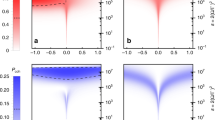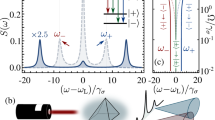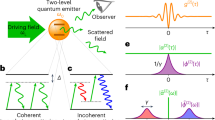Abstract
Resonance fluorescence arises from the interaction of an optical field with a two-level system, and has played a fundamental role in the development of quantum optics and its applications. Despite its conceptual simplicity, it entails a wide range of intriguing phenomena, such as the Mollow-triplet emission spectrum1, photon antibunching2 and coherent photon emission3. One fundamental aspect of resonance fluorescence—squeezing in the form of reduced quantum fluctuations in the single photon stream from an atom in free space—was predicted more than 30 years ago4. However, the requirement to operate in the weak excitation regime, together with the combination of modest oscillator strength of atoms and low collection efficiencies, has continued to necessitate stringent experimental conditions for the observation of squeezing with atoms. Attempts to circumvent these issues had to sacrifice antibunching, owing to either stimulated forward scattering from atomic ensembles5,6 or multi-photon transitions inside optical cavities7,8. Here, we use an artificial atom with a large optical dipole enabling 100-fold improvement of the photon detection rate over the natural atom counterpart9 and reach the necessary conditions for the observation of quadrature squeezing in single resonance-fluorescence photons. By implementing phase-dependent homodyne intensity-correlation detection9,10,11, we demonstrate that the electric field quadrature variance of resonance fluorescence is three per cent below the fundamental limit set by vacuum fluctuations, while the photon statistics remain antibunched. The presence of squeezing and antibunching simultaneously is a fully non-classical outcome of the wave–particle duality of photons.
This is a preview of subscription content, access via your institution
Access options
Subscribe to this journal
Receive 51 print issues and online access
$199.00 per year
only $3.90 per issue
Buy this article
- Purchase on Springer Link
- Instant access to full article PDF
Prices may be subject to local taxes which are calculated during checkout



Similar content being viewed by others
References
Schuda, F., Stroud, C. R. Jr & Hercher, M. Observation of the resonant Stark effect at optical frequencies. J. Phys. B 7, L198–L202 (1974)
Kimble, H. J., Dagenais, M. & Mandel, L. Photon antibunching in resonance fluorescence. Phys. Rev. Lett. 39, 691–695 (1977)
Höffges, J. T., Baldauf, H. W., Lange, W. & Walther, H. Heterodyne measurement of the resonance fluorescence of a single ion. J. Mod. Opt. 44, 1999–2010 (1997)
Walls, D. F. & Zoller, P. Reduced quantum fluctuations in resonance fluorescence. Phys. Rev. Lett. 47, 709–711 (1981)
Heidmann, A. & Reynaud, S. Squeezing in the many atom resonance fluorescence emitted in the forward direction: application to photon noise reduction. J. Phys. (Paris) 46, 1937–1948 (1985)
Lu, Z. H., Bali, S. & Thomas, J. E. Observation of squeezing in the phase-dependent fluorescence spectra of two-level atoms. Phys. Rev. Lett. 81, 3635–3638 (1998)
Raizen, M. G., Orozco, L. A., Xiao, M., Boyd, T. L. & Kimble, H. J. Squeezed-state generation by the normal modes of a coupled system. Phys. Rev. Lett. 59, 198–201 (1987)
Ourjoumtsev, A. et al. Observation of squeezed light from one atom excited with two photons. Nature 474, 623–626 (2011)
Gerber, S. et al. Intensity-field correlation of single-atom resonance fluorescence. Phys. Rev. Lett. 102, 183601 (2009)
Ou, Z. Y., Hong, C. K. & Mandel, L. Detection of squeezed states by cross correlation. Phys. Rev. A 36, 192–196 (1987)
Vogel, W. Homodyne correlation measurements with weak local oscillators. Phys. Rev. A 51, 4160–4171 (1995)
Yuen, H. P. Two-photon coherent states of the radiation field. Phys. Rev. A 13, 2226–2243 (1976)
Teich, M. C. & Saleh, B. E. A. Squeezed states of light. Quantum Opt. 1, 153–199 (1989)
Walls, D. F. Squeezed states of light. Nature 306, 141–146 (1983)
Caves, C. M. Quantum limits on noise in linear amplifiers. Phys. Rev. D 26, 1817–1839 (1982)
Goda, K. et al. A quantum-enhanced prototype gravitational-wave detector. Nature Phys. 4, 472–476 (2008)
Warburton, R. J. et al. Giant permanent dipole moments of excitons in semiconductor nanostructures. Phys. Rev. B 65, 113303 (2002)
Michler, P. et al. Quantum correlation among photons from a single quantum dot at room temperature. Nature 406, 968–970 (2000)
Kim, J., Benson, O., Kan, H. & Yamamoto, Y. A single-photon turnstile device. Nature 397, 500–503 (1999)
Xu, X. et al. Coherent optical spectroscopy of a strongly driven quantum dot. Science 317, 929–932 (2007)
Vamivakas, A. N., Zhao, Y., Lu, C.-Y. & Atatüre, M. Spin-resolved quantum-dot resonance fluorescence. Nature Phys. 5, 198–202 (2009)
Flagg, E. B. et al. Resonantly driven coherent oscillations in a solid-state quantum emitter. Nature Phys. 5, 203–207 (2009)
Akopian, N. et al. Entangled photon pairs from semiconductor quantum dots. Phys. Rev. Lett. 96, 130501 (2006)
Young, R. J. et al. Improved fidelity of triggered entangled photons from single quantum dots. New J. Phys. 8, 29 (2006)
Müller, M., Bounouar, S., Jöns, K. D., Glässl, M. & Michler, P. On-demand generation of indistinguishable polarization-entangled photon pairs. Nature Photon. 8, 224–228 (2014)
Matthiesen, C., Vamivakas, A. N. & Atatüre, M. Subnatural linewidth single photons from a quantum dot. Phys. Rev. Lett. 108, 093602 (2012)
Matthiesen, C. et al. Phase-locked indistinguishable photons with synthesized waveforms from a solid-state source. Nature Commun. 4, 1600 (2013)
Kuhlmann, A. V. et al. Charge noise and spin noise in a semiconductor quantum device. Nature Phys. 9, 570–575 (2013)
Stanley, M. J. et al. Dynamics of a mesoscopic nuclear spin ensemble interacting with an optically driven electron spin. Phys. Rev. B 90, 195305 (2014)
Loudon, R. Squeezing in resonance fluorescence. Opt. Commun. 49, 24–28 (1984)
Acknowledgements
We acknowledge financial support from the University of Cambridge, the European Research Council ERC Consolidator Grant Agreement No. 617985 and the EU-FP7 Marie Curie Initial Training Network S3NANO. C.M. acknowledges Clare College Cambridge for financial support through a Junior Research Fellowship. We thank E. Clarke, M. Hugues and the EPSRC National Centre for III-V Technologies for the wafer and C. Baune, R. Moghadas Nia, W. Vogel, G. Rempe, H. J. Carmichael and A. Ourjoumtsev for discussions.
Author information
Authors and Affiliations
Contributions
C.H.H.S. and M.A. devised the experiment, C.H.H.S., J.H., A.E.J., C.M. and C.L.G. performed the experiments, C.H.H.S., J.H. and C.L.G. developed the models and analysed the data, all authors contributed to the discussion of the results and the manuscript preparation. C.H.H.S. and C.M. processed the quantum dot device.
Corresponding author
Ethics declarations
Competing interests
The authors declare no competing financial interests.
Supplementary information
Supplementary Information
This file contains Supplementary Text and Data comprising: 1 Theory of homodyne intensity autocorrelation measurement; 2 Wigner Functions; 3 Theoretical power dependence for Figure 3; and additional references. (PDF 108 kb)
Rights and permissions
About this article
Cite this article
Schulte, C., Hansom, J., Jones, A. et al. Quadrature squeezed photons from a two-level system. Nature 525, 222–225 (2015). https://doi.org/10.1038/nature14868
Received:
Accepted:
Published:
Issue Date:
DOI: https://doi.org/10.1038/nature14868
This article is cited by
-
Light squeezing enhancement by coupling nonlinear optical cavities
Scientific Reports (2024)
-
Dynamic resonance fluorescence in solid-state cavity quantum electrodynamics
Nature Photonics (2024)
-
Deterministic freely propagating photonic qubits with negative Wigner functions
Nature Photonics (2023)
-
Tailoring solid-state single-photon sources with stimulated emissions
Nature Nanotechnology (2022)
-
Master equations for Wigner functions with spontaneous collapse and their relation to thermodynamic irreversibility
Journal of Computational Electronics (2021)
Comments
By submitting a comment you agree to abide by our Terms and Community Guidelines. If you find something abusive or that does not comply with our terms or guidelines please flag it as inappropriate.



